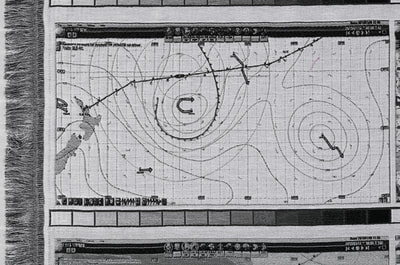This series of work is based on a trans-Pacific voyage on a container ship in 2014-15 documented here www.artistatsea.com/.
With twice daily satellite feeds to the on-board computer, weather software graphically maps the ship’s route, the air pressure, currents, height and direction of sea swell, water temperature, wind directions and speed. Consulted regularly by officers on the bridge, a reassuring human and technology interaction, I captured elements which were later translated into cloth, a tangible visualization of the momentarily lighted screen. Each thread and color can represent multiple information - latitude, longitude, air pressure, shoreline, position, ship route – yet poor resolution of image, or cloth, suggests only a gesture, or data as a ‘material’ of cultural currency.
Beyond writing on the poor image, Hito Steyerl also links the stable horizon with the subsequent development of linear perspective, enabling Western domination and colonization, and “for redefining standards of representation, time and space.” In our digital age, large volumes of data are interpreted, arranged or processed by algorithms, a new form of mapping, creating patterns of meaning that drives the contemporary trade routes. This series of work explores the implications of the digital sphere for us as humans and what visual code can look like, when translated through cloth – one of the earliest communication technologies.
With twice daily satellite feeds to the on-board computer, weather software graphically maps the ship’s route, the air pressure, currents, height and direction of sea swell, water temperature, wind directions and speed. Consulted regularly by officers on the bridge, a reassuring human and technology interaction, I captured elements which were later translated into cloth, a tangible visualization of the momentarily lighted screen. Each thread and color can represent multiple information - latitude, longitude, air pressure, shoreline, position, ship route – yet poor resolution of image, or cloth, suggests only a gesture, or data as a ‘material’ of cultural currency.
Beyond writing on the poor image, Hito Steyerl also links the stable horizon with the subsequent development of linear perspective, enabling Western domination and colonization, and “for redefining standards of representation, time and space.” In our digital age, large volumes of data are interpreted, arranged or processed by algorithms, a new form of mapping, creating patterns of meaning that drives the contemporary trade routes. This series of work explores the implications of the digital sphere for us as humans and what visual code can look like, when translated through cloth – one of the earliest communication technologies.












